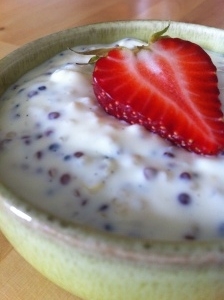Are You Eating the Right Breakfast?
/I don’t know if the old saying “breakfast is the most important meal of the day” is true. It may not be the most important meal. But it certainly is an important one. Starting off with the right breakfast raises your blood sugar gradually and keeps you full for hours. It’s like armor protecting you from the tempting, junky foods that surround us all day. In other words, eating the right breakfast can help with healthy weight loss. Are you eating the right breakfast?
The Right Breakfast
The great news is that there isn’t just one perfect breakfast. Many foods can make up the “right” breakfast. Here are the 4 important characteristics of the “right” breakfast (and some food ideas):
- Produce. I highly doubt that you’re surprised that I ‘m recommending that you include fruit or vegetables in your breakfast. Most of us could use to eat more and so why not get a serving or two in at the start of the day? Eat a piece of fruit, top your oatmeal with berries, add some spinach in your omelet, or warm up last night’s stir-fry leftovers.
- Protein. Here’s something that toast or cereal eaters often miss. Including protein will help your blood sugars be stable for longer, which means no mid-morning crashes and cravings for donuts. Sprinkle hemp hearts or chia seeds on your cereal, spread nut butter on your toast, or enjoy a couple of eggs.
- Real whole grains. This one is optional. You may just want to include protein and produce and you’ll be doing great. Others (me included) do better with some real whole grains at breakfast. What do I mean by “real” whole grains? I mean minimally processed grains. Something that you really have to chew. There’s a lot of highly processed breakfast foods that claim to be whole grain and/or high fibre. I recommend avoiding anything that’s super light-weight, like a lot of breads and puffed cereals. They digest really fast and your blood sugar starts to drop quickly. Instead look for something that needs a lot of chewing, like steel-cut oats and is heavy to hold, like many sprouted grain breads.
- Sugar. Again no surprises here (except where it can be hidden). Have as little added sugar as you can (ideally none). Watch out for it in “healthy” cereals, take-out smoothies made with fruit drink concentrates, and in “fruit”-on-the-bottom yogurt.
Here's a recipe for Overnight Oats - a fantastic example of the right breakfast. Try it tomorrow morning and see how great you can feel!





















